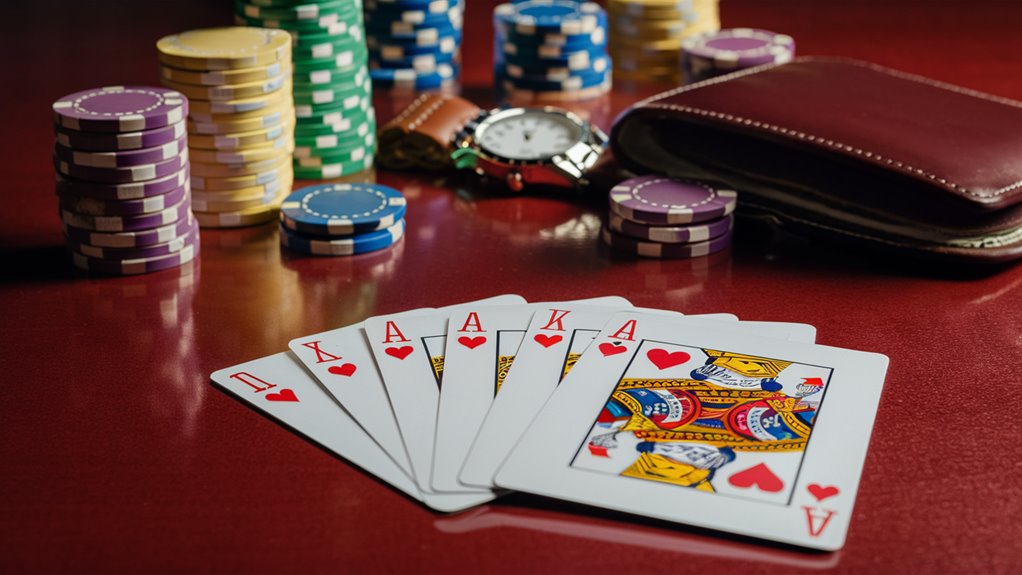Table of Contents
ToggleLearn Poker Like a Pro: Know the Basic Rules

Key Poker Rules
Starting to play poker well starts with knowing the main rules that make some players win more than others. Learning the order of hands well – from a single high card up to the best hand, the royal flush – sets up your base to play better. Knowing your place at the table is one of the strong parts of poker, changing how you decide in every game.
Smart Money Handling
Good players use tight money rules. Keep at least 20 buy-ins for normal games and 50 buy-ins for big games. This safe net lets you choose moves without worry, helping you use better game plans for sure.
Playing from a Good Spot
Playing from a later position gives you a top hand in poker, showing what other players do first. Use smart force from good spots while keeping a small range if you start early. Smart betting sizes back up your table image and get the most from strong hands.
Top Player Moves
Grow in spotting and using the habits of others by watching and thinking. Know the math of poker, like pot odds, more odds, and values you expect 토토사이트먹튀검증. These top ideas, mixed with playing from the right spot, lift your game to pro levels.
Thinking Fast
Knowing players goes past easy signs to see their bets and timing. Pros use mind edges by keeping even paces and shaking up table moves through planned force and timed moves.
Key Rules and Words in Poker
Main Poker Rules
Winning at poker starts by learning needed rules and words.
Players fight for the pot by using cards they get to make the strongest hand or by making others give up.
Basic Poker Words
- Hand: The cards each player has
- Pot: The total bets from everyone
- Call: Meeting the bet on the table
- Raise: Making the bet more
- Fold: Dropping out and losing bets
Order of Poker Hands
Hand ranks go from high to low values:
- Royal Flush
- Straight Flush
- Four of a Kind
- Full House
- Flush
- Straight
- Three of a Kind
- Two Pair
- One Pair
- High Card
The Basics of Texas Hold’em
The well-loved game Texas Hold’em deals each player two own cards while giving out five for all.
Key parts of play:
- Position: Where you sit by the dealer
- Betting rounds: Pre-flop, flop, turn, river
- Blinds: Must-bet to start the action
- Community cards: For all to use
Knowing Hand Ranks
The Order of Poker Hands
Knowing poker hand ranks is key for smart play.
This full list shows the order from best to least, helping you to pick smart moves at key times.
Top Poker Hands
The royal flush is best in poker, using an Ace, King, Queen, Jack, and 10 of the same suit. The next best, the straight flush, has five cards in a row of one suit. Four of a kind shows as the third-best hand, with four same cards.
Middle Hands
A full house mixes three same cards with a pair, making a strong five-card hand. The flush uses five cards in the same suit, not in line, while a straight needs five in line no matter the suit.
Basic Hand Ranks
Three of a kind has three matching cards, followed by two pair, which uses two sets of pairs. A single pair means two same cards, and a high card is if no other hand is possible.
Smart Hand Choices
Learning hand ranks in poker is more than just memory.
Key skills:
- Figuring odds for hands
- Guessing other hands
- Using your spot in bets
- Thinking of pot odds and hand strength
This knowledge helps in choosing bets, bluff chances, and how to do well at the table.
Handling Your Money
Must-Follow Money Rules
Smart poker players know that good money rules are the key for long play wins. Keep at least 20 buy-ins at your level for normal games. For example, with $1/$2 games needing $200 buy-ins, have a $4,000 base. Big game players should have 50 buy-ins due to big ups and downs.
Risk Rules
Smart money rules need you to stick to plans. Never risk more than 5% of all your money on one game. When losing more than usual, don’t try to get it back with bigger bets. Instead, use a strong plan by playing lower levels when your total money drops too much.
Track and Think It Through

Record Each Game
Keep a full list of every game, noting:
- Money used
- Money won
- How long you played
- Levels played
- Win or lose each time
Check Your Playing
Track main points to help your money grow:
- Win money each hour
- Get back what you put in (ROI)
- Ups and downs
- How you do at each level
- How your total money changes
Smart Money Growth
Smart money plans focus on steady growth, not fast wins. Building a strong poker money base needs you to be patient and follow risk rules well.
This careful way keeps you safe from big changes while helping you make more over time in both normal and big games.
About Spots and Betting Times
Knowing Where to Sit
Your spot in poker is a big part of winning. The dealer button shows when each player goes during the bets. Late spots like dealer, near dealer, and one before give big edges, letting you see what others do first. This helps you play more kinds of hands and have better chances to win. Early spots like small and big blind, and first to go have it tough as they go first with less info, needing a tight play and strong cards to make up for the weak spot.
How to Bet in Rounds
The Start of Betting
The first bet sets how the hand starts. Think about these:
- How strong your hand is
- Your spot by the dealer
- How much money you have
- How the table feels
How to Bet Later
Each part of the game needs its own plans:
Thinking on the flop:
- Look at the cards on show
- Think about the pot size
- Guess other players’ hands
- Chances to keep betting
What to do on the turn and river:
- Narrow down possible hands
- Figure pot odds
- Think of more odds
- How to bet for most value
- Bluff based on what happened before
Your spot and betting rounds shape a strong poker plan, where when you play, what you know, and smart choices mean a lot for long wins.
Guessing Other Players
Seeing How They Act
Understanding others in poker needs you to study how they act, their betting ways, and body signs well. Top players make a plan to spot how others play by watching and noting both what they say and do not say while playing.
What Their Bets Mean
How they bet tells a lot about their style. Watch:
- How often they bet in different spots
- How much they raise in various times
- How they react to stronger plays
- Changes that show how strong their hand is
Body Signs
Body signs show more about their hand strength and how sure they are:
- How they sit and move
- How they handle chips
- How they breathe
- Where they look and focus
- How fast they decide
Using What You Know
Good guessing of signs needs:
- Growing a full list of players
- Seeing steady signs
- Changing your play based on what you see
- Knowing signs can guess but not promise outcomes
- Putting together many clues to choose
Seeing the Big Picture
How the game feels can change how reliable signs are. Think about:
- How good players are
- Where you sit
- How much money is in play
- What happened in past hands
- If it’s a normal game or a big one
Plans and Moves
Where to Sit and Basic Ideas
Your place at the table is key to playing poker well. Late spots are great as they let you see what others do first. This helps in making smart moves like taking the pot with well-timed bluffs and better choices.
Better Betting Moves
Smart force is a must in poker. Players balance strong bets with good hands and sometimes weaker hands to keep others guessing. Even bet sizes stop others from guessing your moves and keeps your table image strong. From Rookie to Pro in No Time
Math in Choices
Knowing pot odds helps in making choices that count in poker. Players weigh possible wins against costs, while more odds consider extra chips you might win later. This math base is a steady way to make sure you win more.
Picking and Managing Hands
The best hand picks often use 20-25% of hands dealt, looking at top cards and cards in a line of the same suit. This careful way helps you make more while facing fewer tough spots.
Bluffing and How to Bet After the Flop
Half-bluffs with possible winning hands make two ways to win – making others fold now or ending up with the best hand. Keep betting on the flop to look strong and keep the lead no matter the cards, making a key part of play after the flop.
